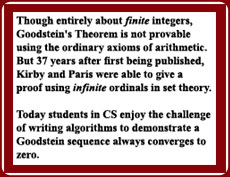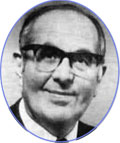Pick a number - a positive integer - expressed
in simple base notation.
Then repeatedly - recursively - perform the
following two operations:
|
|
What will happen? The answer is the number eventually converges to 0. Most people incorrectly guess the sequence goes to infinity. Let's begin by studying this recursion in simple base notation.
| For number = 4
and base = 2,
Start. [1, 0, 0] (base 2) = 4 [1, 1] (base 3) = 4 [1, 0] (base 4) = 4 [3] (base 5) = 3 [2] (base 6) = 2 [1] (base 7) = 1 [0] (base 8) = 0 |
For number = 3
and base = 2,
Start. [1, 1] (base 2) = 3 [1, 0] (base 3) = 3 [2] (base 4) = 2 [1] (base 5) = 1 [0] (base 6) = 0 |
For number = 5
and base = 3,
Start. [1, 2] (base 3) = 5 [1, 1] (base 4) = 5 [1, 0] (base 5) = 5 [4] (base 6) = 4 [3] (base 7) = 3 [2] (base 8) = 2 [1] (base 9) = 1 [0] (base 10) = 0 |
For number = 10
and base = 8,
Start. [1, 2] (base 8) = 10 |
Now that you have examined simple base notation, you are ready to tackle Goodstein's Sequence, which uses hereditary base notation. Amazingly, Goodstein's Sequence also converges to 0!

If base two is recursively incremented to base three, the right side of the expression becomes

The Goodstein Sequence is therefore

The following applet is written in the Goodstein hereditary base notation. Enter a number, its base, and then select "Start." If you select a number greater than 3 base two, the recursion can take a long time to converge and requires your computer to have sizable memory. [Note: We suggest you begin with 3 base two; and then try 4 base three. After these two examples that converge quickly, try other larger numbers. Please observe that if the base is larger than the number, the sequence converges quickly. Even numbers as small as 4 base two can increase for approximately 2.6 × 1060605351 steps]. The program will terminate if the number becomes to large.
|
For the
more advanced student. . . .
 Goodstein's statement about natural numbers cannot be proved using only Peano's arithmetic and axioms. Goodstein's Theorem is proved in the stronger axiomatic system of set theory by applying Gödel's Incompleteness Theorem. The Incompleteness Theorem asserts that powerful formal systems will always be incomplete. That is to say, there will exist true statements that the system cannot prove nor disprove. Gödel's Incompleteness Theorem assures us that we must believe Goodstein's theorem even if it cannot be proved by mathematical induction. The crucial insight for Goodstein's sequence is that the iterations are well-ordered. In our examples, note that the order of the iteration counted backwards, always goes to zero. Interestingly, the
Goodstein
sequence is unique in that it may calculate
large numbers before
the size of the base forces the sequence to
converge to zero. The
calculation for larger numbers reaches a point
where the computer may
be unable to continue. Many personal
computers will simply
cease the calculation. |
|

Related
Reuben Goodstein (1912 - 1985) was a student of Littlewood's at Cambridge. See "Hardy and Littlewood." |
 R. L. Goodstein |
Matthew Nelson, FITSC Lab, CSULA, 2004 Jonathan Sahagun, 2018 |

